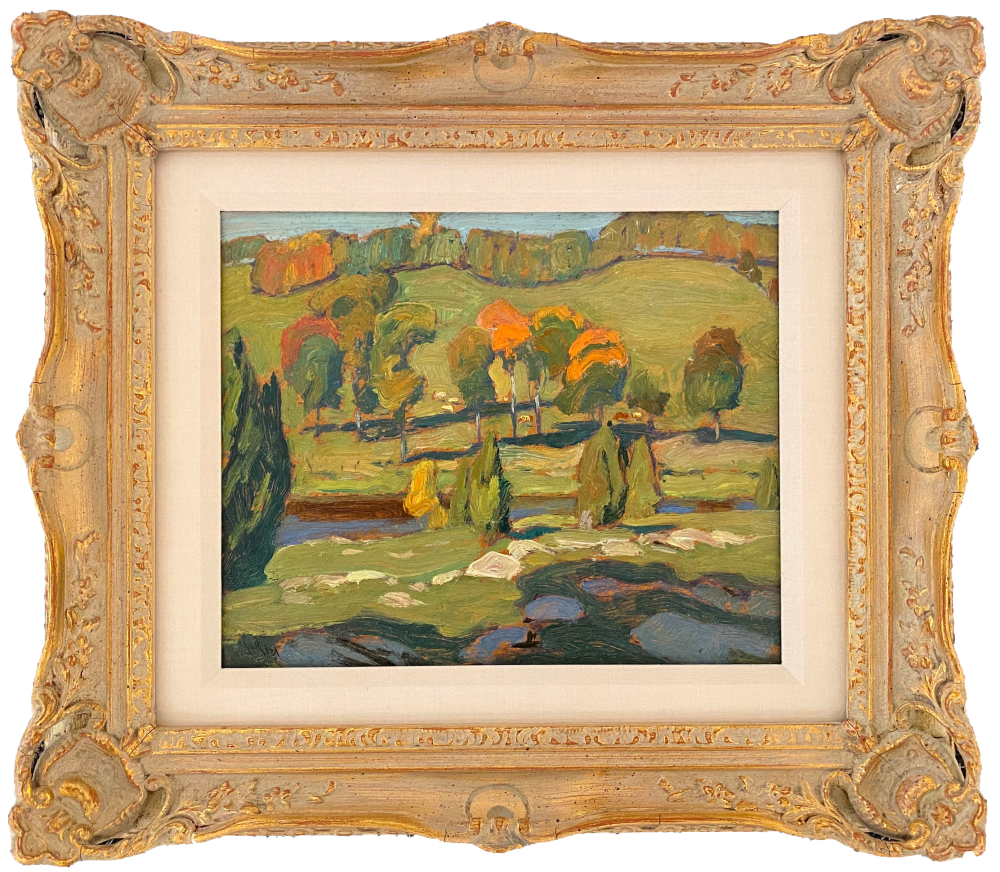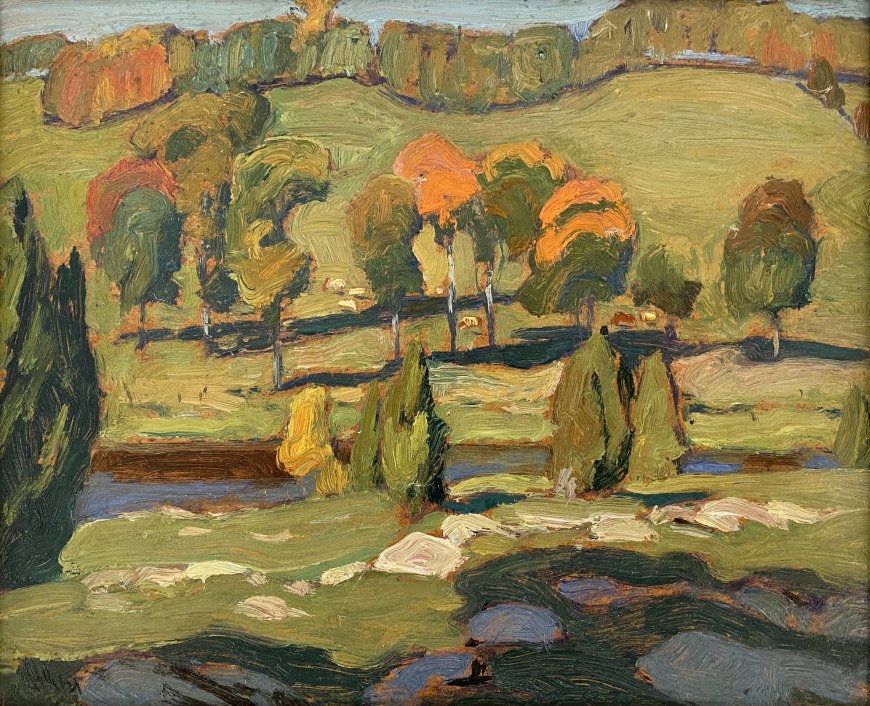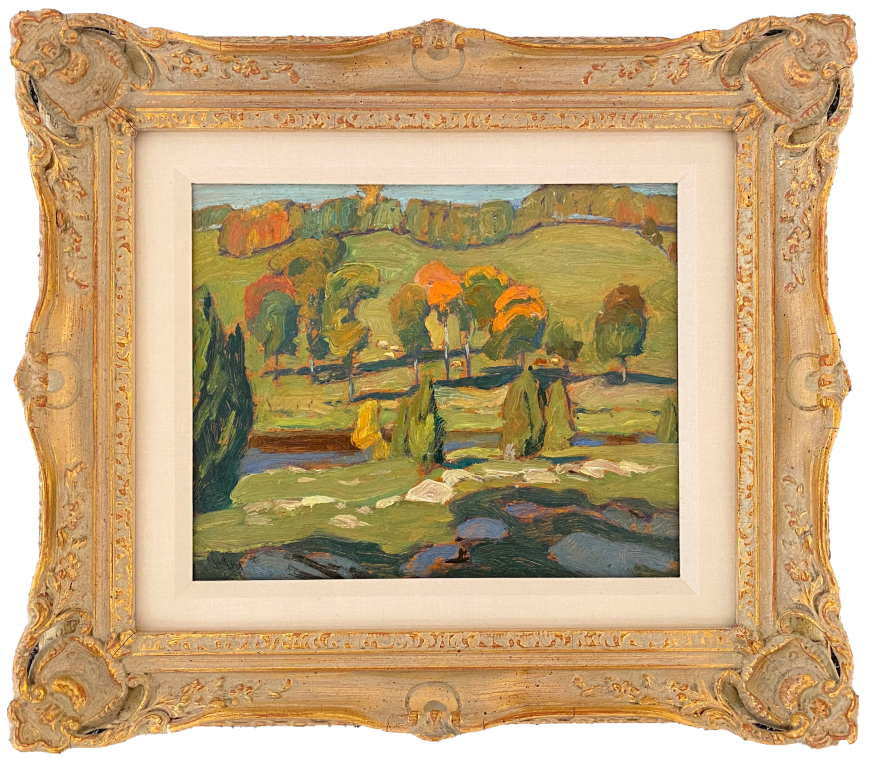-
Artworks
J.E.H. MacDonaldRiver Pastures, Gull River, 19211873-1932Oil on cardboard8 1/2 x 10 1/2 inCopyright Alan Klinkhoff Gallery
21.6 x 26.7 cmSoldInscriptions
signed and dated, ‘JM’/ 21 (lower left); titled, signed and dated by the artist, ‘Gull River / J.E.H. MacD. / ‘21 / River Pastures / J.E.H. MacDonald / 1921’ (verso, centre)Provenance
Laing Fine Art Galleries Limited., Toronto, circa 1950
Private collection, Montreal
By descent to the present owners
Literature
E.R. Hunter, J.E.H. MacDonald A Biography & Catalogue of his Work (Toronto: The Ryerson Press, 1940), 26-27, 54
Nancy E. Robertson, J.E.H. MacDonald, R.C.A., 1873-1932 (Toronto: Art Gallery of Toronto, 1965), 41
Paul Duval, The Tangled Garden (Scarborough: Cerebrus/Prentice-Hall, 1978), 141
Robert Stacey, “Chronology and Selected References,” in Robert Stacey/Hunter Bishop, J.E.H. MacDonald Designer (Ottawa: Archives of Canadian Art an imprint of Carleton University Press, 1996), 121
J.E.H. MacDonald was the oldest member of the Group of Seven and his career first developed within the context of an earlier definition of Canadian art. In the 1890s and first decade of the twentieth century, Canadian artists focused on the rural aspects of the landscape and the hard fought growth of small settlements and farms, as seen in the annual calendars of the Toronto Art League, of which MacDonald was a member. With an invalid wife and son to support, in the early 1920s his time was taken up with the financial responsibilities of teaching at the Ontario College of Art leaving him little time to paint. While on occasion he joined his fellow artists on expeditions to the wilder landscapes of Algonquin Park and Algoma, he also returned to rural subjects sketched on brief holidays at Lake Simcoe or in the Haliburton region of Ontario, south-west of Algonquin Park. A good map of the area can be found on page 732 in volume two of David Milne Jr.’s and David Silcox’s catalogue raisonné of the paintings of David Milne (University of Toronto Press, 1998).
Paul Duval informs us that MacDonald spent his summer 1921 holiday visiting a former co-worker from the design firm Grip Ltd., where the future members of the Group of Seven had first met before the First World War. Fred Peel lived at Coboconk on the Gull River and owned a lumber mill and cottage nearby. While initially developed by the lumber industry, the area had since been cleared of trees allowing the growth of pastures and farms. River Pastures, Gull River is a lyrical sketch painted in a delightful palette of greens and oranges. The rocky foreground bears evidence of the thinness of the soil covering, though sufficient for grazing cattle, visible amidst the trees in the middle ground.
Grazing cattle on the Gull River was the subject of two of MacDonald’s canvases, Cattle by the Creek of 1918 (National Gallery of Canada) and River Pastures, Gull River of 1922. In both canvases the foreground is occupied by water and the trees and cattle are arranged across the middle of the composition in a horizontal band. E.R. Hunter, author of the early biography of J.E.H. MacDonald, described River Pastures, Gull River as “a symphony in green” with “a balanced unity of all the parts.”
From a label on the verso we can deduce that this sketch was acquired by Laing Fine Art Galleries around the time of its move from 60 Bloor Street East to 194 Bloor Street West in 1950.
Charles C. Hill for Alan Klinkhoff Gallery
All Rights Reserved













